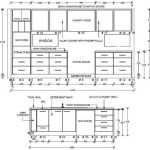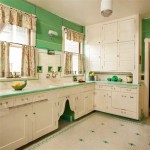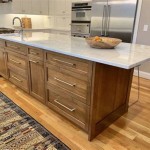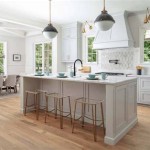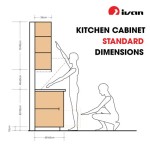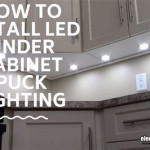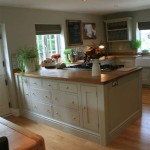Painting Oak Kitchen Cupboards White: A Comprehensive Guide
Oak kitchen cupboards, while durable and often aesthetically pleasing in their natural state, can sometimes feel dated or out of sync with evolving design trends. Painting them white is a popular method for refreshing a kitchen, creating a brighter and more modern atmosphere. This process, however, requires careful planning, meticulous execution, and the right materials to achieve a professional and lasting finish. This article details the steps involved in successfully painting oak kitchen cupboards white, emphasizing best practices and addressing common challenges.
Preparation: The Foundation for a Flawless Finish
Proper preparation is arguably the most crucial element of a successful cabinet painting project. Failing to adequately prepare the surfaces can lead to paint adhesion issues, uneven coverage, and ultimately, a less-than-desirable outcome. This phase encompasses several key steps, each designed to create a clean, smooth, and receptive surface for the primer and paint.
Removing Hardware and Doors: The first step involves removing all hardware from the cupboards and drawers. This includes hinges, knobs, pulls, and any other decorative elements. Labeling each piece of hardware and its corresponding location is highly recommended, as it simplifies the reassembly process. Following hardware removal, detach the doors and drawers from the cabinet frames. This allows for easier access and a more even application of paint. Lay the doors and drawers flat on a protected work surface for painting. Consider using painter's pyramids or small blocks to elevate the doors off the surface, preventing sticking and allowing for complete edge coverage.
Cleaning and Degreasing: Oak cabinets, especially in a kitchen environment, accumulate grease, grime, and dust over time. These contaminants will prevent paint from adhering properly, leading to peeling and chipping. Begin by wiping down all surfaces with a clean, damp cloth to remove loose debris. Next, use a strong degreaser, following the manufacturer's instructions. Trisodium phosphate (TSP) is a common and effective option, but be sure to wear appropriate safety gear, including gloves and eye protection, as it is a strong alkaline cleaner. Alternative degreasers are available at most hardware stores, marketed specifically for kitchen cleaning. Rinse all surfaces thoroughly with clean water after degreasing to remove any residue. Allow the cabinets to dry completely before proceeding.
Sanding: Sanding is essential for creating a textured surface that promotes paint adhesion and for smoothing out any imperfections. For oak cabinets, which typically have a pronounced grain, using a medium-grit sandpaper (around 120-grit) for the initial sanding is advisable. Focus on sanding in the direction of the wood grain to avoid creating cross-grain scratches. After the initial sanding, switch to a finer-grit sandpaper (around 220-grit) to further smooth the surface. Pay close attention to corners and edges, ensuring they are evenly sanded. Use a sanding block or a detail sander for hard-to-reach areas. The goal is not to completely remove the existing finish, but rather to scuff it up to create a "tooth" for the primer to grip. After sanding, remove all sanding dust with a tack cloth or a vacuum cleaner with a brush attachment. A clean surface is crucial for optimal primer adhesion.
Filling Grain (Optional but Recommended): One of the primary challenges in painting oak cabinets white is the inherent grain pattern. While some individuals appreciate the texture, others prefer a smoother, more uniform surface. To minimize the appearance of the grain, a grain filler can be applied. Water-based or oil-based grain fillers are available. Apply the grain filler according to the manufacturer's instructions, typically by spreading it evenly across the surface and then removing the excess with a plastic scraper or a damp cloth. Allow the grain filler to dry completely, typically 24-48 hours, before sanding it smooth. Use a fine-grit sandpaper (around 320-grit) for sanding the grain filler, being careful not to remove too much of it. The objective is to create a smooth, even surface that minimizes the visibility of the grain.
Priming: Priming is a critical step that cannot be skipped. Primer provides a uniform base for the paint, blocks stains, and enhances adhesion. An oil-based or a high-quality stain-blocking primer is recommended for oak cabinets. These primers are effective at preventing tannins from bleeding through the paint, which can cause discoloration, especially when using white paint. Apply the primer in thin, even coats using a high-quality brush or a sprayer. Allow the primer to dry completely according to the manufacturer's instructions, typically 24 hours. After the primer is dry, lightly sand it with a fine-grit sandpaper (around 320-grit) to smooth out any imperfections. Remove all sanding dust before applying the paint.
Application: Achieving a Smooth and Durable Finish
The application of the paint itself requires patience and attention to detail. Choosing the right paint and application method is crucial for achieving a professional-looking, durable finish that will withstand the rigors of a kitchen environment.
Selecting the Right Paint: For kitchen cabinets, a high-quality acrylic latex or alkyd paint is recommended. Acrylic latex paints are water-based, easy to clean up, and offer good durability. Alkyd paints, also known as oil-based paints, provide a harder, more durable finish, but require mineral spirits for cleanup. Consider the desired sheen level as well. Semi-gloss or gloss finishes are typically used for kitchen cabinets because they are easier to clean and resist moisture better than matte finishes. However, glossier finishes also tend to highlight imperfections more, so a smoother surface preparation is even more critical. Ensure the paint is specifically formulated for cabinets or trim for optimal adhesion and durability.
Choosing the Application Method: There are two primary methods for applying paint to kitchen cabinets: brushing and spraying. Brushing is a traditional method that requires skill and patience. Use a high-quality brush designed for the type of paint being used (synthetic for latex paints, natural bristle for oil-based paints). Apply the paint in thin, even strokes, following the direction of the wood grain. Avoid overloading the brush, as this can lead to drips and runs. Spraying provides a smoother, more uniform finish than brushing. An airless sprayer is the most common type of sprayer used for cabinet painting. It requires practice and proper setup to avoid drips and overspray. Always wear a respirator when spraying paint, as the fumes can be harmful. Regardless of the application method, multiple thin coats are always preferable to one thick coat. Thin coats dry more evenly and are less prone to drips and runs.
Applying the Paint: Apply the first coat of paint in thin, even layers, ensuring complete coverage. Allow the paint to dry completely according to the manufacturer's instructions, typically 24 hours. After the first coat is dry, lightly sand it with a fine-grit sandpaper (around 320-grit) to smooth out any imperfections. Remove all sanding dust before applying the second coat. Apply the second coat of paint in the same manner as the first. Two coats of paint are usually sufficient to achieve full coverage and a durable finish. However, if using a light color over a dark surface, a third coat may be necessary. Allow the final coat of paint to dry completely for at least 48 hours before reassembling the cabinets.
Reassembly and Finishing Touches: Completing the Transformation
Once the paint has fully cured, the final steps involve reassembling the cabinets and adding the finishing touches that will complete the transformation and ensure the longevity of the painted finish.
Reattaching Hardware and Doors: Carefully reattach the hardware to the doors and drawers, using the labels that were created during the removal process. Ensure that all screws are tightened securely but not over-tightened, as this can strip the wood. Rehang the doors and drawers on the cabinet frames, ensuring that they align properly and swing smoothly. Adjust the hinges as needed to achieve proper alignment. Replacing old hardware with new hardware can further enhance the updated look of the kitchen.
Applying a Protective Topcoat (Optional): A clear topcoat can provide an extra layer of protection against scratches, scuffs, and stains, especially in high-traffic areas like around the sink and stovetop. Water-based polyurethane is a common choice for protecting painted cabinets. Apply the topcoat in thin, even layers using a brush or sprayer, following the manufacturer's instructions. Allow the topcoat to dry completely before using the cabinets. Lightly sanding between coats of topcoat with very fine-grit sandpaper (around 400-grit) can further enhance the smoothness and durability of the finish.
Caulking Gaps: Caulking any gaps between the cabinets and the walls or other surfaces can improve the overall appearance and prevent moisture from seeping into the cabinets. Use a paintable caulk and apply it neatly, using a wet finger or a caulk smoothing tool to create a smooth, even bead. Allow the caulk to dry completely before painting over it.
Cleaning and Maintenance: Once the cabinets are fully reassembled and the paint has cured, clean them with a mild soap and water solution. Avoid using harsh chemicals or abrasive cleaners, as these can damage the painted finish. Regularly wiping down the cabinets with a damp cloth will help to keep them clean and prevent the buildup of grease and grime. With proper care and maintenance, a professionally painted set of oak kitchen cabinets can provide years of beauty and functionality.

Painting Oak Cabinets White Best Diy Tutorial 2024

Painting Oak Cabinets White An Amazing Transformation

Best Paint For Kitchen Cabinets 24 Brands Blind Tested 2024

Are You Thinking Of Painting Your Kitchen Cabinets Read This First

Diy Painted Oak Kitchen Cabinets Makeover

Tips Tricks To Paint Honey Oak Kitchen Cabinets Cottage Living And Style

Painting Oak Wood Cabinets To Give Them An Updated Look

Glossy White Paint On Honey Oak Kitchen Cabinets Before After

Painting Kitchen Cabinets White Beneath My Heart

Best Paint For Kitchen Cabinets 24 Brands Blind Tested 2024
Related Posts

